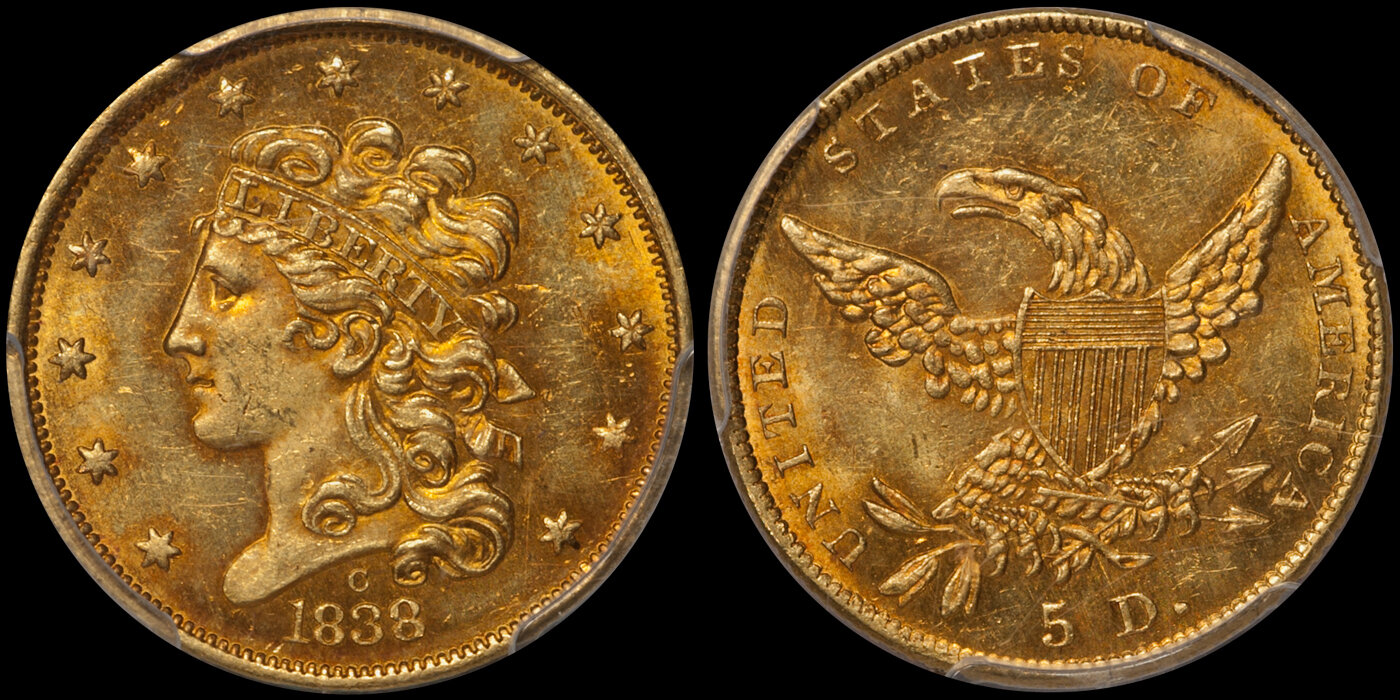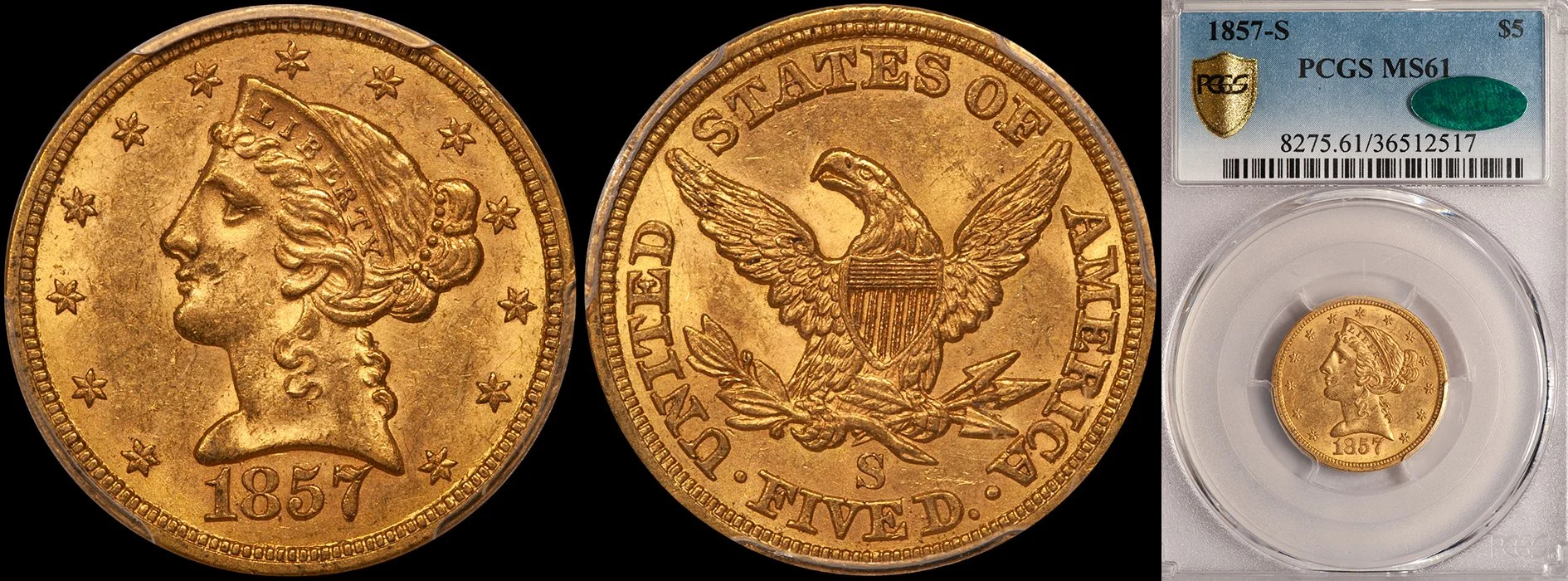Great CAC-pectations
/In recent years, I’ve come across a number of new collectors who are “CAC only” buyers. In the past, I’ve dealt with many collectors who are “CAC preferred” when it comes to their coins, but these new collectors absolutely insist every coin they buy must be CAC approved.
In most 20th century non-gold series, it is possible to put together CAC-only sets. Even with such conditionally challenging series as MS65 Red Lincoln cents or MS65 Buffalo nickels there are enough coins to go around that a well-heeled collector can likely assemble a full set of CAC approved pieces. This is clearly not the case with certain 20th century gold series (Indian Head half eagles and eagles come to mind) where numerous issues are either extremely rare or unknown in MS65 with CAC approval. It is possible to put together great sets of CAC approved Indian Head half eagles, eagles, and St. Gaudens double eagles in high grades, but with some of the coins grading MS63 or MS64.
18th and 19th century gold coins, when collected by date, are a formidable challenge for those who like their coins with CAC approval. In this article, I’m going to look at a few random series and determine how feasible a CAC-only set is and if this is a goal for which a collector should have Great CAC-pectations. For the sake of inclusiveness, we’ll look at each of these series from three collecting levels: collector grade, high end circulated and Uncirculated.
1. CHARLOTTE QUARTER EAGLES
Charlotte quarter eagles include two design types: the Classic Head and the Liberty Head.
1838-C $2.50 PCGS AU55 CAC
The 1838-C represents a very tough issue to locate in collector grades with CAC approval; only four have been stickered in EF45 and below. A collector is more likely to locate one in AU grades as there have been 11 approved to date. Only two have been approved in Uncirculated; making this among the more difficult coins in the set for the high-end collector.
1842-C $2.50 PCGS EF45 CAC
The Liberty Head issues feature some reasonably tough dates but you’d think that all would be obtainable in collector grades with CAC approval. This is not the case. The most challenging dates are the 1842-C (only seven coins in 45 or below are stickered), 1843-C Small Date (only four coins), 1846-C (just two!), 1850-C (four stickered in EF45 and lower), 1851-C (three), 1855-C (three), and 1856-C ( none!).
Ironically, a high-grade circulated set of Charlotte quarter eagles with CAC approval will prove easier to assemble than a set of VF-EFs. There are six dates which have AU CAC populations of five or fewer (1842-C, 1843-C Small Date, 1846-C, 1852-C, 1856-C, and 1860-C) with two having populations of just three (1846-C and 1860-C).
1846-C $2.50 PCGS MS61 CAC
I won’t waste your time discussing the possibility of assembling a full set of Charlotte quarter eagles in Uncirculated all with CAC approval. There are numerous dates which still have never had an Uncirculated example approved and unless something crazy happens, this project remains just about hopeless.
2. CLASSIC HEAD HALF EAGLES
This short set contains just eight issues (more if you include varieties) which should make it fairly easy to complete in all-CAC, right?
Actually, not really…
The 1838-C and 1838-D, while they have CAC populations of 10 and 13, respectively, in EF45 and lower are extremely popular. You probably should be able to locate one if you are patient but it should be noted that CAC populations are cut in half if you focus just on coins in EF grades. An issue which is sneaky hard to locate in collector grades with just eight in EF grades is the 1834 Crosslet 4. Challenging, yes, but certainly not impossible.
In nice AU grades, the 1838-C is a real stopper with just four approved by CAC (I’ve sold all of them!). The 1834 Crosslet 4 has a CAC population of eight, and I can’t recall having seen more than two or three of these.
1838-C $5.00 PCGS MS63+ CAC
An Uncirculated set of Classic Head half eagles with every piece approved by CAC is possible but highly unlikely as just one of these is dated 1838-C (a 63+ which I sold). The sole CAC approved 1838-D is an MS62 and there are but two 1834 Crosslet 4s.
CAC approved examples of the common date Classic Head half eagles are available fairly regularly and they tend to bring significant premiums. As an example, a PCGS AU55 1835 is worth around $1,500 while a CAC approved PCGS AU55 will run you around $2,250. In my opinion, this extra amount is well worth it. The coins approved by CAC are nicer, they are more liquid, and they are in more demand.
3. THREE DOLLAR GOLD PIECES
This seems like a series that should be completable in collector grades with each and every coin approved by CAC. Oh sure, there are a few real toughies such as the 1854-D, 1855-S, and 1873 which are hard to find with CAC approval in Very Fine and Extremely Fine grades, but the rest of the issues shouldn’t be all that hard to locate, right?
Wrong.
While seemingly very collectible in collector grades, there are numerous Three Dollar gold pieces with tiny CAC populations in lower grades. There are seven issues (1867, 1877, 1880, 1881, 1883, 1887, and 1889) which don’t have a single coin graded EF45 and lower approved by CAC. In the case of the 1867 and the 1877, this is due to scarcity. For the other five—all of which are common except for the 1881—it has to do with the fact that the specific issue saw little—if any—circulation.
If we expand the definition of “collector grades” in this series to include About Uncirculated coins, then it becomes easier to complete. There are three dates which will prove very challenging to locate in this range with CAC approval: the 1873 Closed 3 (with only two coins in all AU grades; both in AU53), the 1880 (with just two coins in all AU grades; both in AU58), and the 1884 (not a single coin in AU and just two in the lower Uncirculated grades; one each in MS61 and MS62).
1854-O $3.00 PCGS AU58 CAC
What about assembling a high end set with all of the coins in Uncirculated? Three dates currently have CAC populations of zero: 1854-O, 1855-S and 1860-S. Of these three, the 1854-O is reasonably easy to locate in CAC approved AU55 and AU58, while the 1855-S and the 1860-S each have just four total in the AU55 to AU58 range. Four other dates have just a single Uncirculated coin approved by CAC: the 1854-D (MS62), 1857-S (MS67), 1858 (MS64), and 1873 Closed 3 (MS63PL). However, with the exception of the 1860-S and the 1873 Closed 3, these dates are reasonably obtainable in the AU55 to AU58 range.
4. CARSON CITY EAGLES
Of the three denominations of gold coins struck at the Carson City mint, the most challenging for collectors are the ten dollar gold pieces or Eagles. This series becomes even more of a challenge with CAC approved coins.
1873-CC $10.00 PCGS VF30 CAC
“Collector grades,” when it comes to this series, typically includes coins as low as Very Good or Fine. Taking this into consideration, there are still a number of Carson City eagles which are elusive with CAC approval. The most obvious of these is the 1870-CC with just three approved by CAC in EF45 or lower (two of these are in very low grades), the 1873-CC also with just three approved in EF45 or lower (and none of these higher than VF30), the 1875-CC with a total of five approved in EF45 or lower (with just one of these higher than VF30), and the 1878-CC with four approved in EF45 or lower (with all of these grading VF35 or below).
My personal observation is that the 1870-CC and the 1873-CC will prove very challenging to locate in any grade with CAC approval, while the other two issues will be slightly easier to locate.
A high-end set of Carson City eagles will feature coins grading AU50 to AU55 for the 1870s dates, AU58 to MS61 for the 1880s dates, and MS63 to MS64 for the 1890s dates (except for the 1893-CC which will grade AU58 to MS61).
1870-CC $10.00 PCGS AU50 CAC
There are a number of issues with very low CAC populations in AU grades. These are the 1870-CC with just two, the 1871-CC with three, the 1875-CC with four, the 1877-CC with three, and the 1879-CC also with three.
Building a set of Carson City eagles with all the coins in Uncirculated is impossible, whether or not CAC approved coins are the parameter. A number of the dates from the 1870s are either unknown in Uncirculated or they are unique.
5. TYPE ONE DOUBLE EAGLES
This very challenging series is hard enough to collect with non-CAC coins. Is it feasible to even contemplate with most—or even all—the coins with CAC approval?
The two key issues in a Type One double eagle set are the 1854-O and the 1856-O and, as one would expect, the number of coins with CAC approval is very low. Only two 1854-O double eagles have been approved (one each in VF30 and EF45), while the 1856-O has a total of four with CAC approval (VF20, two in EF45 and AU50).
1860-O $20.00 PCGS EF40 CAC
After these two issues, the key Type One double eagles are the 1855-O, 1859-O, 1860-O, and the 1861-O.
Of these four dates, the one with the lowest CAC population is the 1860-O with six; three of which grade EF45 or below. Next comes the 1859-O with seven approved by CAC; just two of these grade EF45 or below. After this comes the 1855-O with eight approved by CAC; seven of these grade EF45 or below. And trailing these three is the 1861-O with a surprising 16 total approved by CAC; six grade EF45 or below.
These numbers show that an all-CAC Type One Liberty Head double eagle is possible but not very likely. Anyone with enough money (and ambition) to do such a set is certainly not going to settle for a VF30 or EF45 1854-O, and possibly not even an AU50 1856-O.
It seems to me that a CAC-centric Type One set could be assembled with around 90% of the coins approved by this service.
Douglas Winter Numismatics buys and sells choice, original US gold coins with an emphasis on pieces which have been graded by PCGS and approved by CAC. Please contact us directly at dwn@ont.com if you are interested in working with us.




















